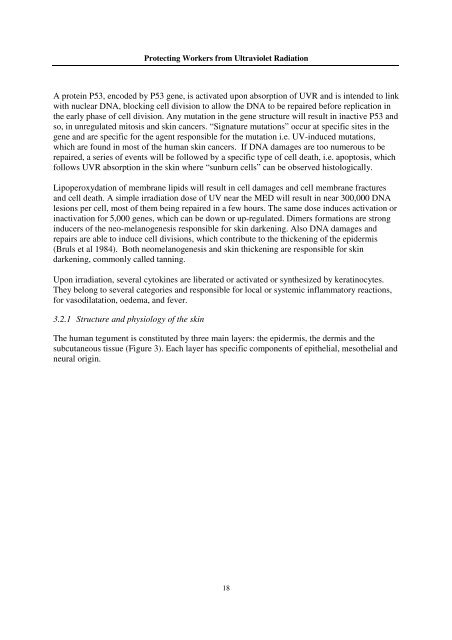Protecting Workers from Ultraviolet Radiation - icnirp
Protecting Workers from Ultraviolet Radiation - icnirp
Protecting Workers from Ultraviolet Radiation - icnirp
Create successful ePaper yourself
Turn your PDF publications into a flip-book with our unique Google optimized e-Paper software.
<strong>Protecting</strong> <strong>Workers</strong> <strong>from</strong> <strong>Ultraviolet</strong> <strong>Radiation</strong><br />
A protein P53, encoded by P53 gene, is activated upon absorption of UVR and is intended to link<br />
with nuclear DNA, blocking cell division to allow the DNA to be repaired before replication in<br />
the early phase of cell division. Any mutation in the gene structure will result in inactive P53 and<br />
so, in unregulated mitosis and skin cancers. “Signature mutations” occur at specific sites in the<br />
gene and are specific for the agent responsible for the mutation i.e. UV-induced mutations,<br />
which are found in most of the human skin cancers. If DNA damages are too numerous to be<br />
repaired, a series of events will be followed by a specific type of cell death, i.e. apoptosis, which<br />
follows UVR absorption in the skin where “sunburn cells” can be observed histologically.<br />
Lipoperoxydation of membrane lipids will result in cell damages and cell membrane fractures<br />
and cell death. A simple irradiation dose of UV near the MED will result in near 300,000 DNA<br />
lesions per cell, most of them being repaired in a few hours. The same dose induces activation or<br />
inactivation for 5,000 genes, which can be down or up-regulated. Dimers formations are strong<br />
inducers of the neo-melanogenesis responsible for skin darkening. Also DNA damages and<br />
repairs are able to induce cell divisions, which contribute to the thickening of the epidermis<br />
(Bruls et al 1984). Both neomelanogenesis and skin thickening are responsible for skin<br />
darkening, commonly called tanning.<br />
Upon irradiation, several cytokines are liberated or activated or synthesized by keratinocytes.<br />
They belong to several categories and responsible for local or systemic inflammatory reactions,<br />
for vasodilatation, oedema, and fever.<br />
3.2.1 Structure and physiology of the skin<br />
The human tegument is constituted by three main layers: the epidermis, the dermis and the<br />
subcutaneous tissue (Figure 3). Each layer has specific components of epithelial, mesothelial and<br />
neural origin.<br />
18



